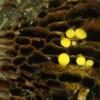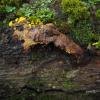
29-12-2025 17:44
Isabelle CharissouBonjour,J'aimerais savoir si d'autres personnes au

29-12-2025 17:12
 Bernard CLESSE
Bernard CLESSE
Bonjour à toutes et tous,Pourriez-vous m'aider à

12-11-2021 00:03
Lepista ZacariasHi everybody,A week ago in my fiels trip I noticed

29-12-2025 17:01
Gernot FriebesHi,I'm looking for help with this hyphomycete with

29-12-2025 08:30
Hello.A tiny ascomycete sprouting under Juniperus

29-12-2025 10:15
Hulda Caroline HolteHello, I found and collected this propoloid ascom

29-12-2025 09:38
Oskari VirtanenHi,could anyone help me identify this, I suspect P

28-12-2025 12:08
Margot en Geert VullingsThis possible Karstenia was found on the bark of d
 asci inamyloid
asci inamyloidSpores: 1-septate
(9.3) 9.6 – 12.7 (15) × (2.8) 3.2 – 4 (4.4) µm
Q = (2.5) 2.6 – 3.6 (4.7) ; N = 35
Me = 11.1 × 3.6 µm ; Qe = 3.1
12.19 3.37
9.86 3.75
10.87 4.08
13.47 3.33
9.76 3.19
9.54 3.84
9.57 3.58
9.58 3.32
11.01 3.56
10.52 3.48
14.48 3.06
11.49 3.64
9.72 3.10
9.47 3.38
10.68 3.34
11.03 3.34
14.67 4.10
10.79 3.86
12.39 3.99
12.25 3.66
10.68 3.63
10.09 3.46
9.92 3.49
12.35 4.05
12.66 3.76
15.04 4.39
9.69 3.44
9.72 3.80
10.49 3.58
10.62 4.04
10.62 3.60
9.99 3.35
12.07 2.83
9.32 3.70
10.89 3.16
Substrate: overmature polypore
Habitat: mixed woods (maple, birch, hemlock, pine, cedar)
Ecoregion: Eastern Forest Boreal-Transition (NA0406)
Collectors: D. Newman
Collected during the 2017 Peck Foray held at the SUNY ESF Newcomb Campus in Newcomb, New York.
also seen at:
https://www.facebook.com/groups/ascomycetes/permalink/1895848247334037/
http://mushroomobserver.org/293285
NOTE: I cannot shrink my images down to 150KB to be uploaded here. they may be viewed at either of the two above links.

Looks for me like Calycina (Bisporella) citrina which may occasionally go on polypores.
But asci should show a reaction, even in MLZ (clearer the reaction would perhaps be in IKI).
Is the excipulum gelatinised and cartilaginous?

First: The type of Bisporella, B. pallescens (Helotiaceae), is not parasitic on Bispora, but Bispora is, unlike Fuckel and Korf & Carpenter assumed, the anamorph (we proved that in culture but did no publish the result except for the mere citation of this relationship in Syllabus 2016.
Second: Bisporella is heterogeneous, a majority belonging to Calycina (Pezizellaceae), including citrina and sulfurina/claroflava. These two species are indeed facultatively fungicolous. For instance, the type of Parthenope parasitica Velen., which is a synonym of C. citrina, grew on a polypore.
Zotto

http://www.gbif-mycology.de/HostedSites/Baral/IodineReaction.htm
https://invivoveritas.de/articles/iodine-reaction-in-ascomycetes-why-is-lugols-solution-superior-to-melzers-reagent/
and realizing the err of my ways. Is Baral's Solution preferable to Lugol's? How is it made/where can it be purchased?
Many thanks for your conitnued assistance. Will look at the excipulum next.
-Danny

The antiseptic Lugol I was thinking is in alcohol, which is not suitable for the present purpose. Lugol has usually a weak concentration (0.3%), but when I look here
http://en.academic.ru/dic.nsf/enwiki/751372/Lugol%27s_iodine
I see a concentration over 5%!
The solution should be deep brown, minimum 0.5%, not looking yellow in a glass bottle. Either you buy crystalline iodine and KI and mixed it in tap water, or you buy the solution.
Zottto

https://www.amazon.com/J-CROWS%C2%AE-Lugols-Solution-Iodine-2/dp/B001AEFM9Y

each drop contains 1 mg iodine and 1.5 mg potassium iodide,
which is actually exactly the formula for Lugol.
1g iodine in 1 l water would be 1%, the optimum concentration.
1000 drops of this Lugol are certainly not 1 l, so the concentration must be very high in this reagent. But you can easily dilute it.
Good is to keep a high concentrated solution behind because iodine escapes slowly from the solution via plastic lids.




